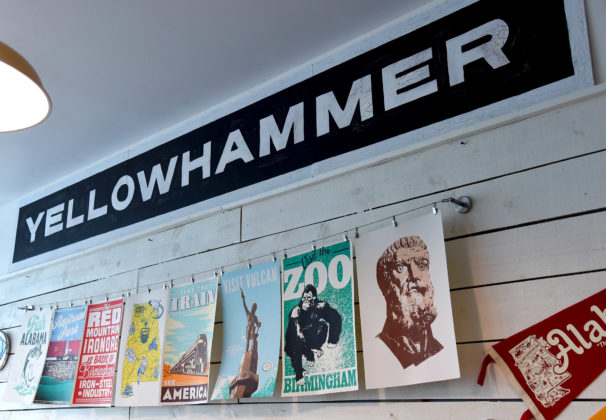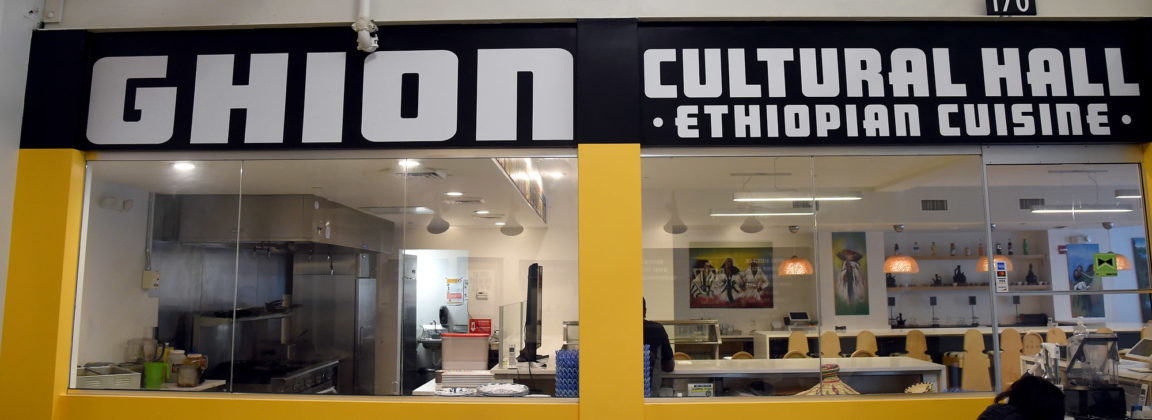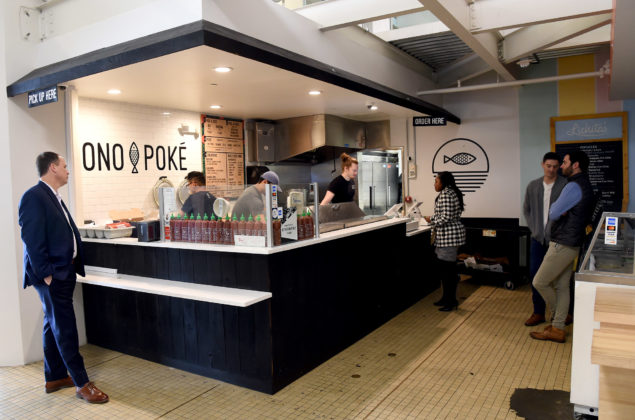
By Erica Wright
The Birmingham Times
When looking for healthy food around lunchtime, Taylor Dean, who works in downtown Birmingham, knows exactly where she wants to go.
“I go to the Pizitz [Food Hall] for my lunch. I enjoy the different healthy options like being able to get a smoothie or fruit bowl from Juiced Up or a bowl from Ono Poke,” said Dean, pointing to two vendors inside the food hall. “I also enjoy the vibe. There’s a good mixture of different people from all different backgrounds. I enjoy seeing the diversity of people … interacting with each other.”
Dean, who works at the Bradley Law Firm, isn’t the only one who enjoys the Pizitz Building, which formally opened in March 2017. Thousands of visitors come to the food hall each month, and its popularity continues to grow after nearly 36 months in business.
“I like the variety of choices here and that we can come together. We don’t have to eat the same thing, but we can still be together, and I think it just has a cool vibe,” said Katie Hausman, who lives in the Highland Park neighborhood and works at the Levite Jewish Community Center.
Located on the corner of 2nd Avenue and 19th Street North, in the heart of Birmingham’s historic retail and theater district, the iconic Pizitz Building has come to represent the city’s past and future.
The Pizitz is a $70 million renovation of a former 1920s department store in downtown Birmingham. The building was restored and transformed by Bayer Properties into a mixed-use destination and now features The Pizitz Food Hall, two restaurants, 143 multifamily residences, modern co-working office space named Forge and the soon-to-open Sidewalk Film Center + Cinema.
Abuzz With People
On any given day, the Pizitz can be found abuzz with people going in and out of their residential spaces or people enjoying a bite to eat from one of the 13 vendor stalls and two restaurants with cuisines from around the world. The building combines modern residences, dining, and retail and office space into one downtown location.
Mindy Rohr, Experience Manager of the Pizitz Food Hall, said developers were mindful of the building’s history when planning the project.
“The Pizitz was the heart of downtown,” she said. “It was a place that people came to shop, so we [looked at how we could] bring that history back to life. How do we not demolish it? … [How do we] bring something new?”
The goal was to restore the Pizitz Building to its former beauty, to keep it as was and “be a supportive piece for the theater district, people visiting Railroad Park, people living in the area,” Rohr said. “In the 2nd Avenue District, there are three or four restaurants, and as far as living, there are only a handful [of locations]. So, we’ve become that part of downtown again.”
The restoration of the 251,000-square-foot building, which had sat vacant for 28 years, was completed in December, 2016.
Since being redeveloped and reopened, the Pizitz Building has created jobs, given people a place to live, and contributed to the success of other businesses downtown—not to mention that it has given local entrepreneurs a place for their business to create a stream of income and become one of the most influential mixed-use projects in Birmingham.
“This architectural gem means so much to the history of Birmingham, and we are delighted to be part of the resurgence of downtown by repurposing this historic building,” said Jeffrey Bayer, founder and owner of Bayer Properties. “Our goal was to create an environment that is a vibrant gathering spot for residents of and visitors to Birmingham. The food hall is a tremendous complement to the office space and apartment homes that are part of the vision, [helping to] fulfill our commitment to create an urban village atmosphere.”
Inside the Pizitz
The Pizitz Food Hall, with its variety of food offerings, is one of the main attractions.
“Each operator is slightly different in nature, [and] they all are local,” said Rohr. “We worked with a blogger group called ‘What to Eat Birmingham,’ a husband-and-wife team when we originally started the project, to help find small operators or somebody looking to do something different or maybe had something [that] was just kind of hidden off a little bit.”
For example, The Standard’s Matt Ralph is a classically trained chef, and “he had this concept he wanted to do, so he’s our burger restaurant,” said Rohr. “We always say it’s like a taste of the world when you come to the Pizitz Food Hall.”
There also is a plan in place to keep the offerings fresh by changing out operators: “It makes sense for somebody to be here for a couple of years and then maybe move on to do a restaurant or do something different. As we progress and this food hall changes, it will be ever-evolving,” Rohr said.
In addition to the food hall and retail stores on the first floor of the Pizitz, the building features event space called The Gallery.
“We do fitness events. We rent it out for wedding receptions, for business groups that want to have a larger meeting space. It’s just kind of a rental space,” said Rohr.
Events at The Gallery include Yoga Lab every Tuesday at 5:45 p.m., as well as Monday Night Music, wellness pop-ups, and the recent Flashback Friday, which featured a DJ.
The Pizitz also has a courtyard for outdoor dining and events, plus a seven-level attached parking deck with more than 300 spaces.
History
The Pizitz Building is named after Russian immigrant Louis Pizitz, who started the Louis Pizitz Dry Goods Company in 1899; the business evolved into a chain of department stores. The eight-story building was designed by Harry B. Wheelock and completed in 1923. At its peak, 13 Pizitz stores were in operation including nine in Birmingham and two in Huntsville. By 1986, the chain was sold to Jackson, Miss.-based McRae’s, though the Pizitz family retained ownership of many of the actual buildings. The downtown Birmingham building was shuttered in 1988, while other locations were converted to McRae’s department stores.
Impact
The redeveloped Pizitz Building has played a key role in the revitalization of downtown Birmingham.
“We have become that central place between Railroad Park and Regions Field and the theater and business districts. … Having the food hall brings that sense of community back to this area,” said Rohr.
Prior to the opening of the Pizitz Food Hall, the downtown area had the Lyric and Alabama theaters and the McWane Center but few food options.
“When [these venues] had events, people had to go somewhere else [for dining options], but now they can come here, park, eat, hang out with us, and go over and see their cinema [event],” Rohr said. “The bring-them-in-and-keep-them aspect has happened [downtown Birmingham] because we are here. I think that’s the role we play and we like to play. We want to be that spot where people come and hang out and feel some sense of community.”
Speaking of cinema, the Sidewalk Moving Picture Festival will occupy a year-round basement-level entertainment space in the Pizitz Building, with office space and two 100-seat screening rooms; the facility is currently under construction and projected to open later this year, in late summer or early fall.
Sidewalk Cinema will join the Imax Dome Theater, which is across the street at the McWane Science Center, and the Alabama, Lyric, and Carver theaters and the Red Mountain Theatre Company Cabaret Theatre, which are just a few blocks away in what is considered downtown Birmingham’s Theatre District.
Another unique feature of the historical rejuvenation is a large antique clock that hangs above the food hall on the north side of the Pizitz Building. The long-forgotten fixture was discovered in the early stages of renovation and restored to its original condition. Bayer Properties leaders decided to relocate the clock to a prominent position within the food hall for all to enjoy.
“Really Cool”
Recent Pizitz Food Hall visitors call attention to another attraction: the architecture.
Simo Sentissi, who lives in Homewood and works downtown, said, “I love that the Pizitz is modernized but still keeps that historical aspect and keeps some of the old designs.”
Katie Hausman said, “I think it’s really cool to put in something that is brand new and so vibrant in a building like this. It gives Birmingham that old-to-new feel that I think the city is really into.”
Taylor Dean said, “I think having a place like this downtown is great because . . . businesses are growing downtown and there’s been a lot of redevelopment down here so it’s great to have a place that reflects that revitalization and redevelopment but also keeps the historical aspect like the Pizitz does.”
And, Rohr not only works at the Pizitz but also lives nearby.
“We’re excited about some of the other hotels opening near Railroad Park. A lot of [Pizitz] residents walk to Railroad Park and are supportive of everything they’re doing over there,” she said. “It’s probably the most sense of community I’ve ever felt anywhere that I have lived.”
This story was updated on 2/15/2019 at 1:36 p.m. to correct Mindy Rohr’s title. She is the Experience Manager of The Pizitz Food Hall.
































